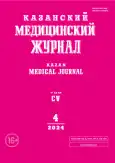Связь галектинов-1 и -3 с проангиогенными факторами и дисфункцией эндотелия при раке толстой кишки
- Авторы: Курносенко А.В.1,2, Рейнгардт Г.В.1,2, Полетика В.С.1, Колобовникова Ю.В.1, Уразова О.И.1
-
Учреждения:
- Сибирский государственный медицинский университет
- Томский областной онкологический диспансер
- Выпуск: Том 105, № 4 (2024)
- Страницы: 551-559
- Раздел: Теоретическая и клиническая медицина
- Статья получена: 10.11.2023
- Статья одобрена: 21.05.2024
- Статья опубликована: 25.07.2024
- URL: https://kazanmedjournal.ru/kazanmedj/article/view/623114
- DOI: https://doi.org/10.17816/KMJ623114
- ID: 623114
Цитировать
Полный текст
Аннотация
Актуальность. Ключевую роль в патогенезе рака толстой кишки отводят индукторам неоангиогенеза — сосудистому эндотелиальному и эпидермальному факторам роста, эффекты которых, вероятно, могут модулировать галектины-1 и -3.
Цель. Изучить взаимосвязь содержания галектинов-1 и -3, сосудистого эндотелиального и эпидермального факторов роста с количеством циркулирующих эндотелиоцитов в крови у больных раком толстой кишки в зависимости от степени дифференцировки опухоли и её распространённости.
Материал и методы. Обследованы пациенты (n=20) с верифицированным диагнозом рака толстой кишки (код по Международной классификации болезней C18–C20), группа сравнения — здоровые добровольцы (n=10), сопоставимые по полу и возрасту. Материал исследования — периферическая кровь. Содержание галектина-1, галектина-3, сосудистого эндотелиального и эпидермального факторов роста оценивали методом иммуноферментного анализа, подсчёт слущенных эндотелиоцитов — проточной цитофлуориметрией. Статистическая обработка выполнена в программном пакете Jamovi 2.3.21 для Windows. Различия между выборками оценены путём вычисления U-критерия Манна–Уитни. Взаимосвязи устанавливали с помощью вычисления коэффициента корреляции Спирмена (ρ). Результаты считали достоверными при уровне статистической значимости р <0,05.
Результаты. У больных колоректальным раком уровень сосудистого эндотелиального фактора выше, чем у здоровых на 18%, уровень галектина-1 — выше в 2,6 раза, галектина-3 — в 1,6 раза по сравнению со здоровыми донорами, уровень эпидермального фактора роста значимо не различался. Содержание галектинов-1 и -3 тесно взаимосвязано между собой (ρ=0,843, p <0,01), с содержанием сосудистого эндотелиального фактора роста в плазме крови (ρ=0,311, p=0,032 — галектин-1; ρ=0,310, p <0,033 — галектин-3 соответственно). Количество десквамированных эндотелиоцитов в крови у пациентов с колоректальным раком выше в 8 раз, чем у здоровых, и напрямую коррелирует с содержанием фактора роста эндотелия сосудов (ρ=0,307, p <0,05), галектина-1 (ρ=0,650, p <0,01) и галектина-3 (ρ=0,622, p <0,01).
Вывод. Увеличение содержания галектинов-1 и -3 в плазме крови больных раком толстой кишки положительно коррелирует с экспрессией сосудистого эндотелиального фактора роста и не зависит от стадии заболевания и степени дифференцировки опухоли.
Полный текст
Об авторах
Анна Васильевна Курносенко
Сибирский государственный медицинский университет; Томский областной онкологический диспансер
Автор, ответственный за переписку.
Email: kurnosenko.av@ssmu.ru
ORCID iD: 0000-0002-3210-0298
SPIN-код: 5649-5611
асп., каф. патофизиологии; врач-онколог
Россия, г. Томск; г. ТомскГлеб Вадимович Рейнгардт
Сибирский государственный медицинский университет; Томский областной онкологический диспансер
Email: glebreyngardt@gmail.com
ORCID iD: 0000-0003-3148-0900
SPIN-код: 8148-5154
асп., каф. патофизиологии; врач-онколог
Россия, г. Томск; г. ТомскВадим Сергеевич Полетика
Сибирский государственный медицинский университет
Email: vpoletika@yandex.ru
ORCID iD: 0000-0002-2005-305X
SPIN-код: 9153-0459
Scopus Author ID: 57202578110
канд. мед. наук, доц., каф. патофизиологии
Россия, г. ТомскЮлия Владимировна Колобовникова
Сибирский государственный медицинский университет
Email: kolobovnikova.julia@mail.ru
ORCID iD: 0000-0001-7156-2471
SPIN-код: 3638-1577
Scopus Author ID: 21934053900
ResearcherId: A-8012-2014
д-р мед. наук., проф., каф. патофизиологии
Россия, г. ТомскОльга Ивановна Уразова
Сибирский государственный медицинский университет
Email: urazova.oi@ssmu.ru
ORCID iD: 0000-0002-9457-8879
SPIN-код: 9696-4110
Scopus Author ID: 6602474101
ResearcherId: A-5110-2014
д-р мед. наук, проф., чл.-кор. РАН, зав. каф., каф. патофизиологии
Россия, г. ТомскСписок литературы
- Каприн А.Д., Старинский В.В., Шахзадова А.О. Состояние онкологической помощи населению России в 2021 году. Москва: МНИОИ им. П.А. Герцена — филиал ФГБУ «НМИЦ радиологии» Минздрава России, 2022. 239 с.
- Корчагина А.А., Шеин С.А., Гурина О.И., Чехонин В.П. Роль рецепторов VEGFR в неопластическом ангиогенезе и перспективы терапии опухолей мозга // Вестник Российской академии медицинских наук. 2013. Т. 68, № 11. С. 104–114. doi: 10.15690/vramn.v68i11.851
- Светозарский Н.Л., Артифексова А.А., Светозарский С.Н. Фактор роста эндотелия сосудов: биологические свойства и практическое значение (обзор литературы) // Journal of Siberian Medical Sciences. 2015. № 5. С. 24. EDN: VDVAKJ
- Олжаев С.Т., Токсанбаев Д.С., Цеймах А.Е., Садыков Н.К. Эндотелиальная дисфункция при некоторых злокачественных новообразованиях органов системы пищеварения // Высокотехнологическая медицина. 2022. Т. 9, № 3. С. 4–9. doi: 10.52090/2542-1646_2022_9_3_4
- Топузова М.П., Алексеева Т.М., Вавилова Т.В., и др. Циркулирующие эндотелиоциты и их предшественники как маркёр дисфункции эндотелия у больных артериальной гипертензией, перенёсших ишемический инсульт (обзор) // Артериальная гипертензия. 2018. Т. 24, № 1. С. 57–64. doi: 10.18705/1607-419X-2018-24-1-57-64
- Bertolini F., Shaked Y., Mancuso P., Kerbel R.S. The multifaceted circulating endothelial cell in cancer: Towards marker and target identification // Nat Rev Cancer. 2006. Vol. 6, N. 11. P. 835–845. doi: 10.1038/nrc1971
- Ochieng J., Leite-Browning M.L., Warfield P. Regulation of cellular adhesion to extracellular matrix proteins by galectin-3 // Biochem Biophys Res Commun. 1998. Vol. 246, N. 3. P. 788–791. doi: 10.1006/bbrc.1998.8708
- Folkman J. Angiogenesis // Annu Rev Med. 2006. Vol. 57. P. 1–18. doi: 10.1146/annurev.med.57.121304.131306
- Dignat-George F., Sampol J., Lip G.Y., Blann A.D. Circulating endothelial cells: Realities and promises in vascular disorders // Pathophysiol Haemost Thromb. 2004. Vol. 33, N. 5–6. P. 495–499.
- Thijssen V.V. Galectins in endothelial cell biology and angiogenesis: The basics // Biomolecules. 2021. Vol. 11. P. 1386. doi: 10.3390/bioml1091386
- Tatsuyoshi F., Funasaka T., Raz A., Nangia-Makker P. Galectin-3 in angiogenesis and metastasis // Glycobiology. 2014. Vol. 24, N. 10. P. 886–891. doi: 10.1093/glycob/cwu086
- Козич Ж.М., Смирнова Л.А., Мартинков В.Н. Опухолевая прогрессия и роль галектинов // Медицинские новости. 2020. № 11. С. 3–7.
- Колобовникова Ю.В., Уразова О.И., Полетика В.С., и др. Особенности экспрессии галектинов 1 и 3 при раке толстого кишечника во взаимосвязи с клинико-морфологическими параметрами опухоли // Фундаментальная и клиническая медицина. 2021. Т. 6, № 4. С. 45–53. doi: 10.23946/2500-0764-2021-6-4-45-53
- Чиж Г.А. Современные возможности прогнозирования метастазирования злокачественных новообразований. Маркёры метастазирования // FORCIPE. 2019. № 1. С. 31–41. EDN: MHQIPE
- Paschke S., Jafarov S., Staib L., et al. Are colon and rectal cancer two different tumor entities? A proposal to abandon the term colorectal cancer // Int J Mol Sci. 2018. Vol. 19, N. 9. P. 2577. doi: 10.3390/ijms19092577
- Jafarov S., Link K.H. Различие рака толстой и прямой кишки с точки зрения эпидемиологии, кацерогенеза, молекулярной биологии, первичной и вторичной профилактики: доклинические исследования // Сибирский онкологический журнал. 2018. Т. 17, № 4. С. 88–98. doi: 10.21294/1814-4861-2018-17-4-88-98
Дополнительные файлы








